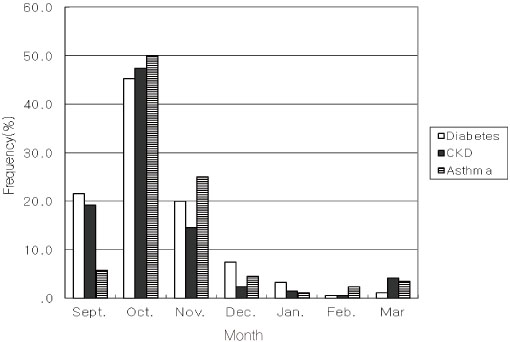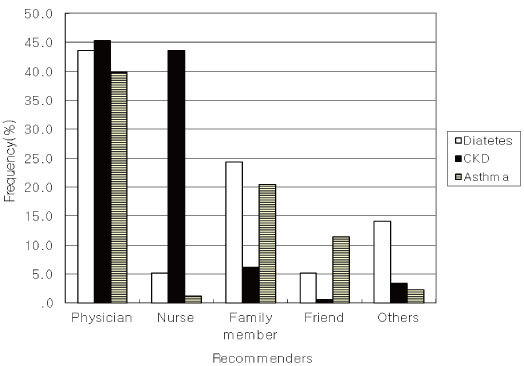Influenza Vaccination Coverage Rate and Factors Associated with Vaccination in People with Chronic Disease
- Affiliations
-
- 1Department of Internal Medicine, Konkuk University School of Medicine, Seoul, Korea.
- 2Department of Internal Medicine, Korea University College of Medicine, Seoul, Korea. wjkim@medimail.co.kr
- 3Department of Preventive Medicine, Korea University College of Medicine, Seoul, Korea.
- KMID: 2285013
- DOI: http://doi.org/10.3947/ic.2011.43.5.406
Abstract
- BACKGROUND
Influenza is a serious illness that causes significant morbidity and mortality, especially in high risk patients. The purpose of this study was to investigate influenza vaccination coverage rate and perceptions of people with chronic disease on vaccination in Korea.
MATERIALS AND METHODS
Patients with diabetes, chronic kidney disease undergoing hemodialysis, and asthma were surveyed. Individual interviews were performed to patients with diabetes visiting the endocrinology department in a university hospital and patients undergoing maintenance hemodialysis in 4 local clinics and 2 university hospitals. Questionnaires were mailed to patients who were registered to have asthma in a university hospital and were asked to mail back. Demographic data, history of vaccination in season 2005-2006, and perceptions on vaccination were asked.
RESULTS
Five hundred and five diabetes patients, 260 hemodialysis patients and 123 asthma patients were analyzed. Influenza vaccination coverage rate was 37.4% in diabetes patients and statistically significant factors associated with vaccination were as follows: lower education level, provider recommendation, previous vaccination, belief in efficacy of vaccination. Forteen and two tenth of patients were recommended to receive influenza vaccine, and the most frequent recommenders were doctors (43.6%). Influenza vaccination coverage rate was 81.9% in patients undergoing hemodialysis and statistically significant factors associated with vaccination were as follows: provider recommendation, previous vaccination, belief in efficacy of vaccination. Sixty six and five tenth of patients were recommended to get influenza vaccination, and the most frequent recommenders were doctors (45.3%) closely followed by nurses (43.6%). Seventy and seven tenth of patients with asthma received influenza vaccination. Previous vaccination was the only statistically significant factor associated with vaccination. Sixty six and nine tenth were recommended to get a vaccination and the most frequent recommenders were doctors (39.8%).
CONCLUSIONS
Influenza vaccination coverage was considerably different among different chronic illnesses. The rate was relatively high in patients with chronic kidney disease undergoing hemodialysis and asthma while it was low in patients with diabetes. The rate of vaccine recommendation was low in all patients and active recommendations by health-care workers should be made.
Keyword
MeSH Terms
Figure
Cited by 6 articles
-
Influenza and Pneumococcal Vaccine Coverage Rates among Patients Admitted to a Teaching Hospital in South Korea
Tae Un Yang, Joon Young Song, Ji Yun Noh, Hee Jin Cheong, Woo Joo Kim
Infect Chemother. 2015;47(1):41-48. doi: 10.3947/ic.2015.47.1.41.Influenza and Pneumococcal Vaccine Coverage Rates among Patients Admitted to a Teaching Hospital in South Korea
Tae Un Yang, Joon Young Song, Ji Yun Noh, Hee Jin Cheong, Woo Joo Kim
Infect Chemother. 2015;47(1):41-48. doi: 10.3947/ic.2015.47.1.41.The Clinical Characteristics of Influenza B Infection during the 2011-2012 Influenza Season
Min Sun Kim, Hyun Woo Sung, E Young Bae, Seung Beom Han, Dae Chul Jeong, Jin Han Kang
Korean J Pediatr Infect Dis. 2013;20(2):89-97. doi: 10.14776/kjpid.2013.20.2.89.Adult Immunization in Patients with Diabetes Mellitus: Current Immunization Status and Recommended Schedule in Korea
Eun-Jeong Joo, Joon-Sup Yeom
J Korean Diabetes. 2013;14(3):103-110. doi: 10.4093/jkd.2013.14.3.103.Hepatitis A Virus Vaccination Status and Related Factors among College Students
Jae Seong Baek, Mi Ah Han, Jong Park, Na-Ra Yun
Korean J Health Promot. 2014;14(3):103-111. doi: 10.15384/kjhp.2014.14.3.103.Influenza Vaccination Status in Korean Adult Population in Relation with Socioeconomic and Medical Factors
Gyeong-Ran Byeon, Yang-Im Hur, Jae-Heon Kang, Hyun-Ah Park, Kyoung-Woo Kim, Young-Gyu Cho, Koh-Eun Shin, Bong-Hee Kang
Korean J Health Promot. 2016;16(1):20-31. doi: 10.15384/kjhp.2016.16.1.20.
Reference
-
1. Nichol KL, Treanor JJ. Vaccines for seasonal and pandemic influenza. J Infect Dis. 2006. 194:Suppl 2. S111–S118.
Article2. Schanzer DL, Langley JM, Tam TW. Co-morbidities associated with influenza-attributed mortality, 1994-2000, Canada. Vaccine. 2008. 26:4697–4703.
Article3. Monto AS. Epidemiology of influenza. Vaccine. 2008. 26:Suppl 4. D45–D48.
Article4. Goodwin K, Viboud C, Simonsen L. Antibody response to influenza vaccination in the elderly: a quantitative review. Vaccine. 2006. 24:1159–1169.
Article5. Brydak LB, Machala M. Humoral immune response to influenza vaccination in patients from high risk groups. Drugs. 2000. 60:35–53.
Article6. Nichol KL, Nordin J, Mullooly J, Lask R, Fillbrandt K, Iwane M. Influenza vaccination and reduction in hospitalizations for cardiac disease and stroke among the elderly. N Engl J Med. 2003. 348:1322–1332.
Article7. Hak E, Buskens E, van Essen GA, de Bakker DH, Grobbee DE, Tacken MA, van Hout BA, Verheij TJ. Clinical effectiveness of influenza vaccination in persons younger than 65 years with high-risk medical conditions: the PRISMA study. Arch Intern Med. 2005. 165:274–280.
Article8. Nichol KL, Nordin JD, Nelson DB, Mullooly JP, Hak E. Effectiveness of influenza vaccine in the community-dwelling elderly. N Engl J Med. 2007. 357:1373–1381.
Article9. Harper SA, Fukuda K, Uyeki TM, Cox NJ, Bridges CB. Advisory Committee on Immunization Practices (ACIP). Centers for Disease Control and Prevention (CDC). Prevention and control of influenza. Recommendations of the Advisory Committee on Immunization Practices (ACIP). MMWR Recomm Rep. 2005. 54:1–40.10. Disase information: influenza. Korea Centers for Disease Control and Prevention. Accessed 5 September 2011. Available at: http://www.cdc.go.kr/.11. Prevention and control of influenza pandemics and annual epidemics. World Health Organization. Accessed 5 September 2011. Available at: http://apps.who.int/gb/archive/pdf_files/WHA56/ea56r19.pdf.12. Blank PR, Schwenkglenks M, Szucs TD. Influenza vaccination coverage rates in five European countries during season 2006/07 and trends over six consecutive seasons. BMC Public Health. 2008. 8:272.
Article13. Linn ST, Guralnik JM, Patel KV. Disparities in influenza vaccine coverage in the United States, 2008. J Am Geriatr Soc. 2010. 58:1333–1340.
Article14. Kee SY, Lee JS, Cheong HJ, Chun BC, Song JY, Choi WS, Jo YM, Seo YB, Kim WJ. Influenza vaccine coverage rates and perceptions on vaccination in South Korea. J Infect. 2007. 55:273–281.
Article15. Blank PR, Schwenkglenks M, Szucs TD. Vaccination coverage rates in eleven European countries during two consecutive influenza seasons. J Infect. 2009. 58:446–458.
Article16. Dower J, Donald M, Begum N, Vlack S, Ozolins I. Patterns and determinants of influenza and pneumococcal immunisation among adults with chronic disease living in Queensland, Australia. Vaccine. 2011. 29:3031–3037.
Article17. Fiore AE, Shay DK, Broder K, Iskander JK, Uyeki TM, Mootrey G, Bresee JS, Cox NJ. Centers for Disease Control and Prevention. Prevention and control of seasonal influenza with vaccines: recommendations of the Advisory Committee on Immunization Practices (ACIP), 2009. MMWR Recomm Rep. 2009. 58:1–52.18. Nichol KL. Improving influenza vaccination rates among adults. Cleve Clin J Med. 2006. 73:1009–1015.
Article19. Schoefer Y, Schaberg T, Raspe H, Schaefer T. Determinants of influenza and pneumococcal vaccination in patients with chronic lung diseases. J Infect. 2007. 55:347–352.
Article20. Mayo Montero E, Hernández-Barrera V, Carrasco-Garrido P, Gil de Miguel A, Jiménez-García R. Influenza vaccination among persons with chronic respiratory diseases: coverage, related factors and time-trend, 1993-2001. Public Health. 2007. 121:113–121.
Article21. Damiani G, Federico B, Visca M, Agostini F, Ricciardi W. The impact of socioeconomic level on influenza vaccination among Italian adults and elderly: a cross-sectional study. Prev Med. 2007. 45:373–379.
Article22. Endrich MM, Blank PR, Szucs TD. Influenza vaccination uptake and socioeconomic determinants in 11 European countries. Vaccine. 2009. 27:4018–4024.
Article23. Statistics by topics. Korea Statistical Information Service. Accessed 10 October 2011. Available at: http://www.kosis.kr/abroad/abroad_01List.jsp.24. Changes in the prevalence of diabetes. Korean National Health and Nutrition Examination Surveys. Accessed 5 September 2011. Available at: http://knhanes.cdc.go.kr/.25. Grilli R, Ramsay C, Minozzi S. Mass media interventions: effects on health services utilisation. Cochrane Database Syst Rev. 2002. CD000389.
Article26. Smith MJ, Ellenberg SS, Bell LM, Rubin DM. Media coverage of the measles-mumps-rubella vaccine and autism controversy and its relationship to MMR immunization rates in the United States. Pediatrics. 2008. 121:e836–e843.
Article27. Leask J, Chapman S, Hawe P, Burgess M. What maintains parental support for vaccination when challenged by antivaccination messages? A qualitative study. Vaccine. 2006. 24:7238–7245.
Article28. Yoo BK, Holland ML, Bhattacharya J, Phelps CE, Szilagyi PG. Effects of mass media coverage on timing and annual receipt of influenza vaccination among Medicare elderly. Health Serv Res. 2010. 45:1287–1309.
Article
- Full Text Links
- Actions
-
Cited
- CITED
-
- Close
- Share
- Similar articles
-
- The Correlates of Influenza Vaccination among Korean Elderly Men and Women
- A Case of Leukocytoclastic Vasculitis after Influenza Vaccination
- Current State of Influenza Vaccination and Factors Affecting Vaccination Rate among Pregnant Women
- Factors Influencing Influenza Vaccination Coverage in Korean Adolescents: Analysis of the Korea National Health and Nutrition Examination Survey IV to VI
- The Influencing Factors of Influenza Vaccination in the Elderly Participating in Lifetime Transitional Health Examination




